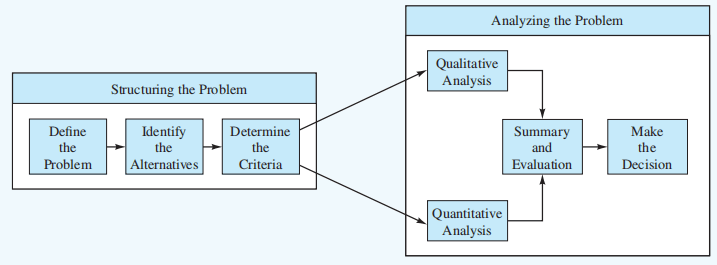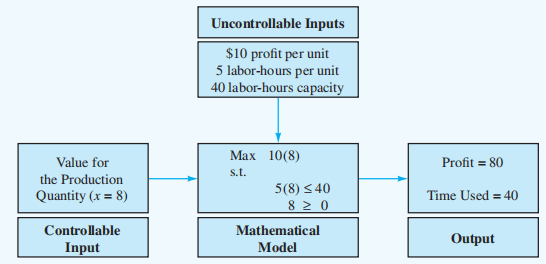Vacabulary for this chapter
Operations Research 运筹学
quantitative 定量的
alternative 选择性的; 替代选择,可供选择的事物
constraints 约束条件
criterion 准则
replicas 复制品
assumptions 假设
restrictions 限制
deterministic 确定性的
stochastic 随机的
probabilistic 概率性的
appropriate 适当的
Body of Knowledge
The body of knowledge involving quantitative approaches to decision making is referred to as
- Management Science (管理科学)
- Operations Research (运筹学)
- Decision Science (决策科学)
Problem Solving and Decision Making
Problem Solving
7 Steps of Problem Solving (First 5 steps are the process of decision making):
- Define the problem.
- Determine the set of alternative solutions.
- Determine the criteria for evaluating alternatives.
- Evaluate the alternatives.
- Choose an alternative (make a decision).
- Implement the selected alternative.
- Evaluate the results.
Quantitative Analysis and Decision Making
Decision-Making Process (5 of the 7 steps)

Problems in which the objective is to find the best solution with respect to one criterion are referred to as singlecriterion decision problems (单准则决策问题).
Problems that involve more than one criterion are referred to as multicriteria decision problems (多准则决策问题).
Analysis Phase of Decision-Making Process
- Qualitative Analysis (定性分析)
- Quantitative Analysis (定量分析)
The role of qualitative and quantitative analysis:

Quantitative Analysis
Model Development
Models are representations of real objects or situations.
Three forms of models are:
- Iconic models (图像模型) - physical replicas (scalar representations) of real objects
- Analog models (模拟模型) - physical in form, but do not physically resemble the object being modeled
- Mathematical models (数学模型) - represent real world problems through a system of mathematical formulas and expressions based on key assumptions, estimates, or statistical analyses
Mathematical Models
Objective Function (目标函数): a mathematical expression that describes the problem’s objective, such as maximizing profit or minimizing cost.
Constraints (约束条件): a set of restrictions or limitations, such as production capacities.
Uncontrollable Inputs (不可控输入): environmental factors that are not under the control of the decision maker
Decision Variables (决策变量): controllable inputs; decision alternatives specified by the decision maker, such as the number of units of a product to produce.
A complete mathematical model for a simple production problem is:
The flowchart for the productino model:

Deterministic Model (确定性模型) – if all uncontrollable inputs to the model are known and cannot vary.
Stochastic (or Probabilistic) Model (随机(或概率)模型) – if any uncontrollable are uncertain and subject to variation
Cost/benefit considerations must be made in selecting an appropriate mathematical model.
Frequently a less complicated (and perhaps less precise) model is more appropriate than a more complex and accurate one, due to cost and ease of solution considerations.
The process of transforming model inputs into output:

Data Preparation
Data preparation is not a trivial step, due to the time required and the possibility of data collection errors.
Model Solution
The analyst attempts to identify the alternative (the set of decision variable values) that provides the “best” output for the model.
The “best” output is the optimal(最佳的) solution.
If the alternative does not satisfy all of the model constraints, it is rejected as being infeasible (不可实行的), regardless of the objective function value.
If the alternative satisfies all of the model constraints, it is feasible(满足的) and a candidate(候选) for the “best” solution.
Model Testing and Validation
Often, goodness/accuracy of a model cannot be assessed until solutions are generated.
Small test problems having known, or at least expected, solutions can be used for model testing and validation.
If the model generates expected solutions, use the model on the full-scale problem.
If inaccuracies or potential shortcomings inherent in the model are identified, take corrective action such as:
- Collection of more-accurate input data
- Modification of the model
Report Generation
A managerial report, based on the results of the model, should be prepared.
The report should be easily understood by the decision maker.
The report should include:
- the recommended decision
- other pertinent information about the results (for example, how sensitive the model solution is to the assumptions and data used in the model)
Implementation
The manager must oversee the implementation and follow-up evaluation of the decision.
The continued monitoring of the model’s performance might lead to model expansion or refinement.
Because implementation often requires people to change the way they do things, it often meets with resistance.
To help ensure successful implementation, include users throughout the modeling process.
Quantitative Methods in Practice
- Linear Programming (线性规划)
- Integer Linear Programming (整数线性规划)
- Project Scheduling: PERT/CPM - PERT (Program Evaluation and Review Technique 统筹法), CPM (Critical Path Method 关键路径方法)
- Inventory Models (库存模型)
- Waiting Line or Queueing Models (排队模型)
- Simulation (模拟)
- Decision Analysis (决策分析)
- Forecasting (预测)
- Markov-Process Models (马尔可夫过程模型)
- Distribution/Network Models (网络模型)

0 条评论
来做第一个留言的人吧!